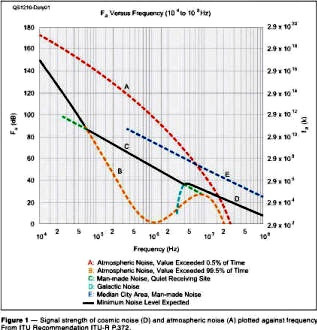
QST is the official publication of the Amateur Radio Relay League (ARRL), the world's oldest and largest organization
for Ham radio enthusiasts. Many amateur radio operators also have an interest in
astronomy and as such, occasionally articles appear covering topics on amateur radio
astronomy. There are also quite a few articles dealing indirectly with aspects of
astronomy such as Earth-Moon-Earth (EME) communications where signals are bounced
off the moon's surface in order to facilitate transmission (although it is really
more of a hobby achievement).
The October 2012 edition of QST had an article entitled, "Those
Mysterious Signals (p37)*," which discusses galactic noise in the 10-meter band.
Arch Doty (W7ACD) writes about the low-level background noise that is persistent
in the high frequency (HF) bands. At HF, Cygnus A and Cassiopeia A are
major sources of cosmic noise, for example. Low level signals come from pulsars,
quasars, black holes, and other remote objects that were created during the early
formation of our universe. However, the strongest background noise emanates from
the center of the Milky Way galaxy with a source that is a mere 27,000 years old.
Radio astronomy amateurs measure and publish relevant information as a resource
for other amateurs as well as for professional radio astronomers. As with most technical
hobbies these days, the state of the art in both equipment and methods is very advanced
- often in the realm of professionals.
Mr. Doty credits Dr. Darryl Emerson for assistance in the writing of the article,
and points readers to two article written for QST by Dr. Emerson (June and July,
1996). The National Radio Astronomy Observatory (NARO) website has a page on their
website with hyperlinks to a few articles on
amateur
radio astronomy,, including the two in QST from Dr. Emerson.
* QST login required
Posted January 12, 2024
(updated from original post on 11/27/2012)
|